Check out our range of stock.
Didn't find what you like?
Send us a message
Found something out of stock?
Send us a message

XY-2838 Jumbo Biological Aquarium Sponge Filter The XY-2838 Sponge filter is largest aquarium sponge filter on the market. The new HI-FLOW has been designed by aquarium breeders to give even greater flow and increased filtration for longer periods between maintenance. Its unique design also makes cleaning a breeze. This Biochemical and mechanical sponge filter will assist in keeping your aquarium clean. The connected air pump (not included) will by pressing air through the core of the filter, create suction. This suction will allow the sponge to capture free floating particles from the water. As a biochemical filter, it will assist in transforming harmful substances by aerobic bacteria, which accumulate in the sponge Biological Filtration Air Driven Sponge size 20cm X 15cm Suitable for Aquariums up to 850 litres
$50.00 $30.00

Oryzias latipes Yang Gui Fei Medaka is a type of fish native to Japan and Taiwan. It is a small, colorful fish that can reach up to 3 inches in length. Its name translates to "beautiful woman from Yang" and it is named for its black and white coloring of its scales, which are said to resemble a woman's cheeks. The fish has a striking pattern of red, blue and yellow along its back, and white or yellow on its belly. It is an active fish that can be found foraging for food in densely planted areas, and it is known for its intelligence and curiosity. Its diet consists of small insects, crustaceans, and other aquatic invertebrates. It can also be kept in tanks with other small fish, but it must be fed carefully to avoid overpopulation.
$15.00

The Yellow Cobra Guppy is a brightly colored aquarium fish that is native to Southeast Asia. It has a yellow-orange body with a dark black cobra-like pattern on its back. It has long, flowing fins, and a forked tail. It is a peaceful, hardy fish and is a great addition to any community aquarium. Its bright color makes it a favorite among aquarium hobbyists. It is an omnivore, so it will feed on a variety of foods, such as flakes, pellets, and live food. The yellow-cobra-guppy is a good choice for novice aquarists, as it is relatively easy to care for and is a very popular fish.
$6.00 - $10.00

The Yellow Cobra Lyretail Guppy is a stunning breed of guppy fish with a vibrant yellow body and a stunning cobra pattern on its fins. Its tail is shaped like a lyre, with a bright yellow and white pattern that stands out against its body. It is an active fish that is known for its hardiness and is a great beginner fish for aquarists. Its diet consists of flake food, freeze-dried, frozen, or live food. It is recommended to keep the Yellow Cobra Lyretail Guppy in a tank with other guppies and peaceful fish.
$7.50 - $15.00

Looking for a vibrant and eye-catching addition to your aquarium? Look no further than the Yellow Flagtail! With its striking yellow coloration and sleek, streamlined body, this fish is sure to be the center of attention in your tank. The Yellow Flagtail, also known as the Yellowtail Barracuda, is a popular choice among aquarists for its beauty and active nature. It adds a burst of color and energy to any freshwater or brackish aquarium setup. With proper care and maintenance, this species can thrive and become a stunning focal point in your aquatic display. At Nano Tanks Australia Aquarium Shop, we offer healthy and high-quality Yellow Flagtails sourced from reputable breeders. We take pride in providing our customers with top-notch specimens that are acclimated to aquarium life. Enhance the visual appeal of your tank and create a captivating underwater landscape with the Yellow Flagtail. Browse our selection now and bring home this stunning fish for your aquarium! These guys are vegetarian however given a choice they do eat meat as well. A great addition if you have a algae issue
$20.00

With its striking coloration and distinctive fins, this guppy is sure to make a statement in your aquarium. Plus, as a peaceful and easy-to-care-for fish, it's perfect for beginner hobbyists and experts alike. Characteristics Family Poeciliidae Origin Native to South America, pet fish are captive-bred Social Peaceful Tank Level Top, mid-dweller Minimum Tank Size 10 gallon Diet Omnivore Breeding Live-bearer Care Beginner pH 6.5 to 8.0 Hardness 100 to 150 mg/L (6 to 8 dH) Temperature 68 to 78 F (20 to 26 C) Origin and Distribution The guppy has been captive bred for over 100 years, but originally came from South America. They are named for Robert John Lechmere Guppy who collected these fish on the island of Trinidad in 1866. They are native to freshwater streams in the north of South America, including Surinam, Guyana, and Venezuela, and the Caribbean islands, including Barbados and Trinidad and Tobago. Now, they have been introduced to every continent but Antarctica, and can be found in many warm waterways around the world. Tankmates Guppies are peaceful, easygoing community fish that play well with a mix of other non-aggressive fish species. You may want to keep them with similar, live-bearing fish, such as platys or mollies. Other good tankmates include small fish, such as neon tetras or zebrafish. Keep in mind that any fry spawned from an active guppy female may be dinner for other fish in the tank, so having smaller tankmates will ensure more fry survive. Many guppy keepers often opt for a guppy-only aquarium. You are welcome to mix different varieties of guppy in the same tank. The number of guppies you can keep in one tank will depend on the size of the tank—a general guideline is 1 gallon of water for every 1 inch of fish. For example, because guppies average around 2 inches in length, a 10-gallon tank may only hold five guppies comfortably, while a 30-gallon tank may hold 15 guppies. Generally, it’s also best to have two or three females for every one male in the tank. Guppy Habitat and Care Guppies are great beginner fish. They are low maintenance and can tolerate some beginner mistakes. A bigger tank size is recommended since guppies are very active fish. They thrive in an aquarium with plants and soft décor items. In order to keep your population from exploding, it is strongly recommended that you separate males and females in different tanks. Guppy females can store sperm for multiple spawns, even after separation from males, so once a female has been with a male, she may have multiple batches of babies. Tank dividers are okay as a temporary solution, but many of these flimsy, plastic dividers are usually not enough to keep fish separated. Two separate tanks will keep unwanted spawning to zero. Heater As a general rule, you need a heater to keep your guppies healthy. They prefer water temperatures in the 70s, and few homes are warm enough to provide that without an immersible heater in the tank. Monitor water temperature daily and adjust the heater as needed to keep your fish comfortable and healthy. Filtration Your aquarium definitely needs a filter to remove impurities and harmful chemicals from the tank water. Without a filter, aquarium water tends to quickly become filled with pollutants from uneaten food and fish waste, and your fish can become ill or even die from this harmful water. There are many types of aquarium filters available to suit any budget, so talk to the fish expert at your local aquarium shop or pet store if you are uncertain as to which filter is best for your tank. Guppy Diet and Feeding Guppies are omnivores and do well on a variety of commercially available feeds. Even though guppies are small in size, pelleted diets called micro pellets are the best choice since they hold onto their nutrition longer than flakes. You are welcome to add supplements, such as frozen fish foods, but no more than once or twice a week. The complete pelleted diet is best for most pet fish species. Depending on your aquarium's temperature and the other tank inhabitants, you may feed your fish once or twice a day. Always start with a little bit of food, and when it has all been consumed, add a little more. Repeat for a few minutes and use this time to check all of your fish. Feeding time is a great time to see if any of your fish are acting odd or sick. Gender Differences There are a few gender differences you will need to identify to keep your male and female populations separate. Males tend to be smaller and more vibrantly colored. Females tend to have a brown coloration and are larger and rounder. Also, as male guppies grow, their body will develop coloration that does not occur on the female's body. On the underside of the fish, the anal fin of the male is long and thin and tapers to a point. The anal fin on the female guppy is larger and triangular or fan in shape. Guppies are sexually mature in about two to three months, and you should be able to identify the differences between genders by 1 month of age, if you wish to separate them. Female guppies first produce offspring at 10–20 weeks of age, and they continue to reproduce until 20–34 months of age. Breeding the Guppy Many beginner hobbyists will start with only one female guppy and suddenly have a swarm. Since female guppies can store sperm, it only takes one insemination by a male for a few spawns to be born. In order to prevent your aquarium from maxing out its stocking capacity, it is always best to separate male and female guppies. Guppies are live-bearers, so the female will give birth to 10–50 wiggling fry per spawning. Many times, the newly born fry will be eaten by other fish in the aquarium, so if you want to save any fish, keep them in a separate tank or breeding box. Heavily planted aquariums will also give the babies places to hide and survive. After breeding together many generations of the same population, you may notice an increased number of fish with congenital abnormalities, such as crooked spines or shortened lifespans.
$60.00 - $90.00

The Yellow Ivy Aquarium Plant is an attractive and hardy aquarium plant that is sure to bring life and color to any aquarium. It is a beautiful, creeping plant with bright yellow foliage that will add a vibrant splash of color to any tank. The Yellow Ivy is easy to care for, requiring only moderate light, a nutrient-rich substrate, and regular trimming to keep it looking its best. It is also great for providing shade and hiding places for fish, shrimp, and other aquatic creatures. This plant is also an excellent choice for oxygenating the water and providing beneficial bacteria to the tank.
$10.00

The Yellow Lace Moscow Guppy is a selectively bred variant of the common guppy (Poecilia reticulata) that features a vibrant yellow coloration with intricate black lace-like patterns on its tail and dorsal fin. This guppy is known for its striking appearance and active, playful behavior. It is a relatively hardy and easy-to-care-for fish that can be kept in community tanks with other peaceful fish species. As with other guppies, Yellow Lace Moscow Guppies are livebearers, meaning that they give birth to live young rather than laying eggs. They are relatively small in size, typically growing to a length of 1.5-2.5 inches (4-6 cm) and have a peaceful disposition. They prefer to be kept in well-planted aquariums with plenty of hiding places and open swimming areas. In terms of care, the Yellow Lace Moscow Guppy requires a balanced diet of high-quality fish food, regular water changes, and adequate filtration to maintain good water quality. They prefer warmer water temperatures, between 72-82°F (22-28°C), and a pH range of 7.0-8.5. With proper care, they can live for 2-3 years or longer.
$60.00

The Yellow Tuxedo Guppy (Poecilia reticulata) is a lovely guppy variety that is now well established in the aquarium world. Natural bright yellow coloration is fairly rare in freshwater animals, but this guppy has plenty of it! We are pleased to offer male/female pairs of this fish so that you can start your own little colony if you wish. Guppies typically occupy the top level of the water column, although they can often be seen swimming and feeding in the middle and bottom levels as well. They are also not afraid to jump, so they must be kept in an aquarium with either a lid/hood/canopy or at least a significantly lowered water level. They will not eat or bother plants. They are safe with other peaceful fish as long as the other fish are not known to nip at the long tail of the guppy. Adult dwarf shrimp are generally safe as well, but guppies may eat shrimp fry. Larger, peaceful invertebrates can also make good tankmates. Guppies are best kept in small groups. While not a picky eater, the Yellow Tuxedo Guppy will thrive and remain very colorful on a varied diet of meaty foods. High-quality flake food, pellets, and frozen or freeze-dried tubifex, and bloodworms will all be readily accepted. What We Like About This Fish: Vibrant bright yellow, blue/purple, and pearl white coloration Peaceful disposition with fish and peaceful invertebrates Hardy and adaptable Excellent for inhabiting the top of the aquarium RECOMMENDED TANK PARAMETERS: Temperature: 64° – 82° F (18° – 27.7° C) pH: 5.5 – 8.0 KH: 10 – 30 dKH Minimum tank size: 10 gallons CARE GUIDELINES: Diet: Omnivorous. Will easily accept high quality dry and frozen foods. Social behavior: Peaceful, schooling/shoaling. Origin: Tank-bred, but indigenous to northern South America. Average adult size: 2.5 inches (6.3 cm), females are larger
$30.00 - $50.00
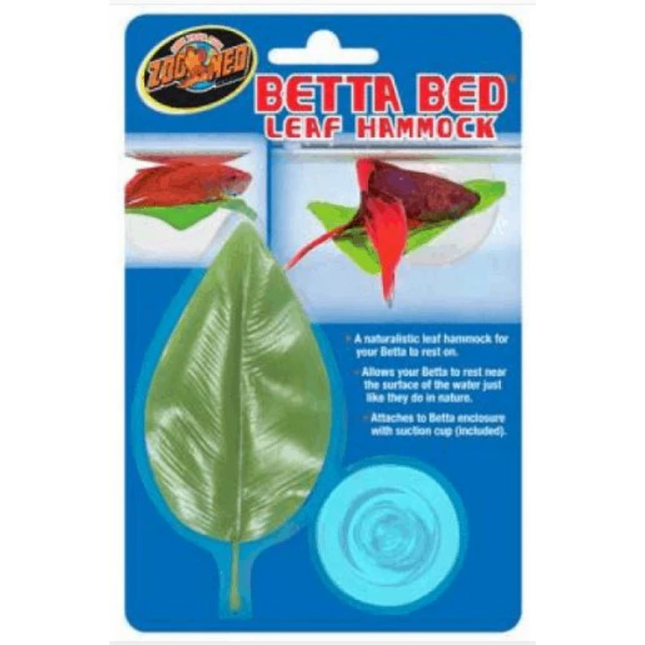
A naturalistic leaf hammock for your Betta to rest on Allows your Betta to rest near the surface of the water just like they do in nature Attaches to Betta Enclosure with suction cup (included).
$6.95
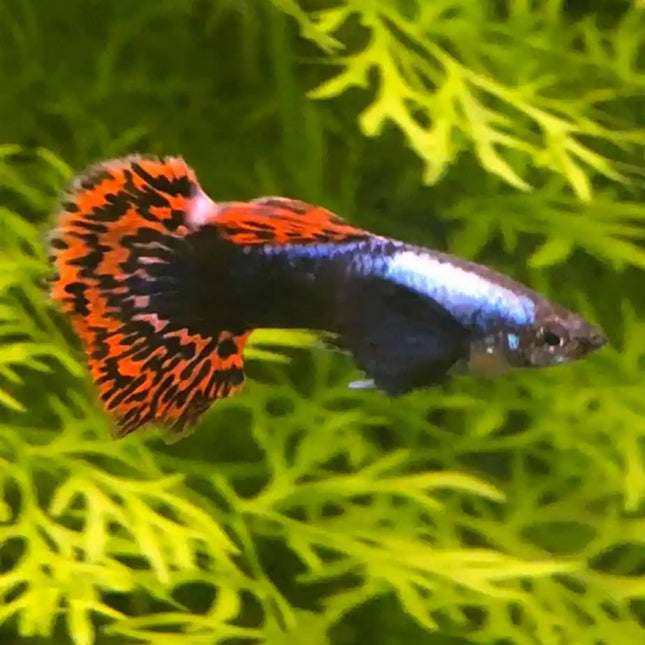
Elegance in Motion. The Crown Jewel of the Guppy World. Introducing the breathtaking Dumbo Mosaic Guppy, a strain that combines two of the most sought-after traits in fancy guppies. Marvel at the enormous, ornate tail adorned with a intricate, mosaic-like pattern of deep blacks, vibrant blues, and fiery reds. Then, be captivated by their namesake "Dumbo" ears—massive, elegantly flapping pectoral fins that make them appear to float like butterflies through your aquarium. This is living art, perfected through selective breeding. Key Features & Benefits: Double Feature Beauty: Experience the stunning Mosaic tail pattern combined with the unique Dumbo (Elephant Ear) pectoral fins for a guppy unlike any other. Captive Bred for Excellence: Our line is selectively bred for vibrant color, robust health, and those signature magnificent fins. They are adaptable and hardy. Constant Activity: Their graceful, flapping swimming motion is a mesmerizing display that brings life and movement to the top levels of your aquarium. Livebearer Ease: Perfect for hobbyists of all experience levels, from beginners to advanced breeders looking to work with a premium strain. Proven Breeders: A fertile pair will provide you with a steady supply of beautiful fry, allowing you to grow your collection or share with other enthusiasts. Product Details: Scientific Name: Poecilia reticulata Common Name: Dumbo Mosaic Guppy, Elephant Ear Mosaic Guppy Origin: Captive Bred Temperament: Peaceful, lively, and social. Size: Males: 3-4cm, Females: 4-5cm What to Get: We recommend starting with a 1 Male & 2 Female trio to ensure a harmonious group and successful breeding. You will receive young, healthy, and sexually mature fish. Care Guide: Recommended Tank Size: 40 litres / 10 US gallons minimum for a trio. Larger tanks are better for maintaining a colony. Water Parameters: Temperature: 22°C - 28°C (72°F - 82°F) pH: 7.0 - 8.0 (They appreciate harder, alkaline water) GH: Prefer moderate to hard water. Diet: Omnivore. Thrives on a varied diet of high-quality guppy flakes or micro-pellets, and frozen or live foods like brine shrimp or bloodworms for optimal color and health. Habitat Setup: A filtered, planted aquarium is ideal. Provide some floating plants to give fry a place to hide. Their long fins can be tempting to nippy tankmates, so choose companions carefully. Who is this guppy for? The Dumbo Mosaic Guppy is the ideal choice for: The aquarist who appreciates the pinnacle of fancy guppy breeding. Beginners looking for a beautiful, hardy, and rewarding fish. Breeders and hobbyists seeking a high-quality strain to work with. Anyone wanting to add a splash of color and elegant movement to a community tank. Order with Confidence: Your live fish order is handled with utmost care. We package all livestock with professional breather bags and insulated boxes, complete with heat or cold packs as needed to ensure a safe journey to your door. ⚠️ Please Note: The size, color, and pattern of livebearers can vary slightly from the parent stock. We strive to provide the highest quality specimens. Long-finned fish should only be kept with peaceful community fish to prevent fin nipping. FAQ Section (Suggested for the product page): Q: What is the best tank setup for these guppies?A: A spacious, well-filtered planted tank is ideal. They appreciate gentle water flow due to their large fins. Include hiding spots for fry if you wish to breed them. Q: What are good tank mates for fancy guppies?A: Excellent peaceful companions include Corydoras catfish, Small Tetras (Neons, Embers), Endler's Livebearers, and peaceful shrimp. Avoid fin-nippers like Tiger Barbs or larger aggressive fish. Q: How can I tell males from females?A: Males are far more colorful with large dorsal and caudal (tail) fins, a slender body, and a gonopodium (modified anal fin). Females are larger with a rounded abdomen, are less colorful, and have a traditional fan-shaped anal fin. Q: Will they breed in my tank?A: Yes, very readily! They are livebearers, meaning the female gives birth to free-swimming fry. To increase fry survival, provide plenty of plants like Java Moss for them to hide in.
$8.00

General care for shrimp: Temperature:18°-24°C Chlorine/chloramines: 0 ppm (very toxic for shrimp) Ammonia/Nitrite: 0 ppm. Nitrate: <20 ppm. pH: 6.2-7.5. GH: 4-8 dGH KH: 3-15 dKH Name Optimal TDS Limits Cherry shrimp 150 – 200 100 – 400 Cardinal shrimp 100 50 – 150 Tiger shrimp 180 – 220 100 – 300 We strongly recommend to drip acclimate any shrimp untill the TDS matches before you release the shrimp into your tank. Please note the above is just a general indication of the care requirements of shrimp. Results will vary depending on the individuals set up.
$12.00
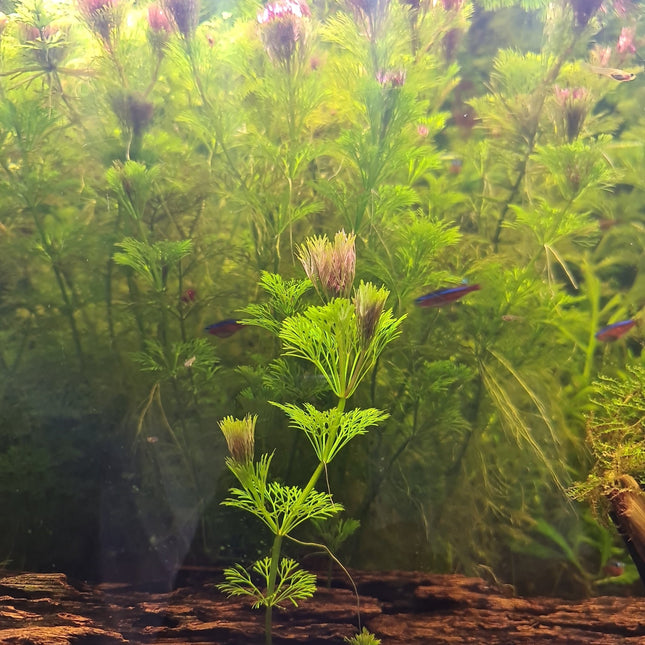
Ambulia is a nice bunched plants that is great for tanks with livebearers or egg scatterers. Ambuilia needs high light to be successful. However when it is established it will grow fast. Please note that the way we sell these are different from other stores. They are best sold loose and best planted loosely.. They are a great source for infusoria and other small invertebrates. Ideally these are floated at the top of the aquarium We grow this in our display tanks Difficulty Easy to keep. Best to keep with species of fish that do not consume plant material. Water Conditions Temperature: 22 - 28°C pH: 5.5 – 8.0 Water Hardness: 70 – 300ppm
$8.00
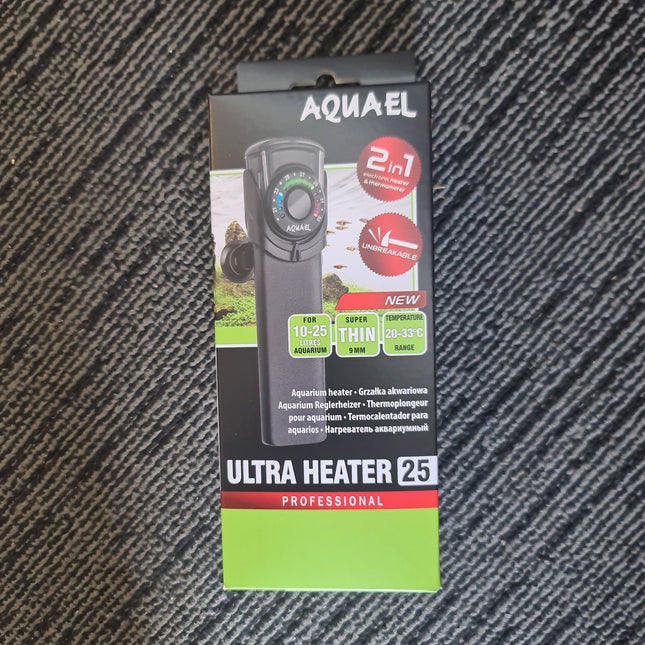
PRODUCT DESCRIPTION Guide on heater wattage to fish tank size ULTRA HEATER 25W: 10-25 LitresULTRA HEATER 50W: 15-50 LitresULTRA HEATER 75W: 35-75 75 LitresULTRA HEATER 100W: 60 – 100 LitresULTRA HEATER 150W: 90-150 LitresULTRA HEATER 200W: 130 – 200 Litres ULTRA HEATER – The first smart aquarium heaters. New in 2020 – Smart Heating System*. A microprocessor controller selects the lowest heating power necessary for maintaining the set water temperature in the aquarium. When necessary, the microprocessor increases or decreases the power to maintain the set temperature. Using the Smart Heating System allows for lower temperature amplitude of aquarium water thanks to the more stable operation of the device. In addition, the SHS positively affects the durability of the heating element and the heater’s lifespan.The heater is programmed using a very convenient ONE-TOUCH system featuring a single button and an LED ring indicating current and set temperatures.The electronic thermostat offers unique precision of +/-0.25°C, maintaining constant temperature in the aquarium, ensuring thermal comfort for even the most sensitive aquarium species.Temperature control range from 20 do 33°C makes it possible to use the heater in the treatment of many fish diseases, including the so-called “fish smallpox”.ULTRA HEATER features also a built-in warning system in case of water overheating in hot weather. Shatterproof plastic housing makes the ULTRA HEATER water heaters perfect for tanks with large, strong fish and even with water turtles. The devices are completely safe and will not cause burns to even such sensitive fish as catfish and rays.The ULTRA HEATER range encompasses 6 models ranging from 25 to 200 W, and are available in 3 lengths, which allows precise adjustment to aquarium size.ULTRA HEATER devices are the most advanced products on the market intended for heating water in aquariums.Heating aquarium water has never been so intuitive and safe. See for yourself! Features: One Touch System – convenient temperature control with one button Built-in thermal switch – the heater is automatically switched off in case of excessive temperature increase in hot weather Fully electronic – no parts of the thermostat are prone to mechanical failure Built-in electronic thermostat – displays current water temperature in the tank using a colour-display Crack-resistant enclosure made of special plastic Precise electronic thermostat (+/-0.25°C) Heater operation and current temperature indicated with colour LEDs Suited for operation in freshwater and saltwater aquariums The ULTRA HEATER deices are manufactured according to the most stringent European safety standards, ensuring safe operation and maintenance. Each unit is tested and calibrated at the AQUAEL laboratory, ensuring precision. Made in Poland *SHS is available with 75 – 200 W heaters manufactured from the beginning of 2020. In order to check whether the heater is equipped with SHS, check the manufacturing date indicated on the plug.
$70.00 - $100.00
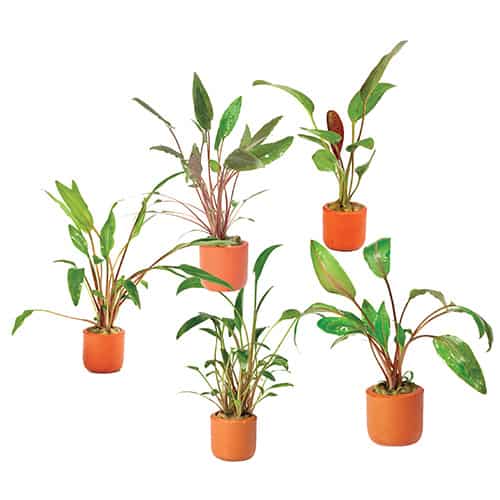
The following are on offer in an assorted basis:Mi OyaLuteaHybridPetchiiWalkeriFamily: AraceaeOrigin: Sri LankapH: 5.5 – 8Temperature: 20 – 30° CHeight: 5 cm – 40 cmLighting: Low
$10.00

Assorted Platy 5cm is a hardy and colorful freshwater tropical fish. They have a round, flattened body with a dorsal fin and a bright, bold color pattern. They are easy to care for and can be kept in a community tank with other peaceful fish. They are omnivores and will eat a variety of foods. They can reach up to 5 cm in length and are a great addition to any aquarium.
$6.00
![[ARRIVED 5 - JUN - 2025] Bacopa caroliniana 5 stems 10cm tall - Nano Tanks Australia](http://nanotanksaustralia.com.au/cdn/shop/files/arrived-5-jun-2025-bacopa-caroliniana-5-stems-10cm-tall-466097.png?v=1749114201&width=645)
Bacopa Caroliniana – The Hardy & Beginner-Friendly Stem Plant Origin: Native to the United States.Size: Stems grow 10–30 cm long with leaves 3–4 cm wide.Growth Habit: Branches readily from the base, forming lush, bushy clusters. Why Choose Bacopa Caroliniana? ✔ Low Maintenance – Perfect for beginners! Thrives with minimal care.✔ Slow Growth – Unlike fast-growing stems, it won’t overcrowd your tank quickly.✔ Easy Propagation – Simply trim a side shoot and replant into the substrate. Aquascaping Tips 🌿 Plant in small groups for a natural, decorative effect.🌿 Ideal for midground/background in nano or larger tanks.🌿 Versatile – Adapts to a range of lighting and water conditions. A timeless favorite for effortless beauty in planted aquariums!
$10.00 $6.00
![[ALWAYS IN STOCK] Bacopa Sessiliflora japan - The Versatile Mid - Ground Stunner (5 stems 10cm) - Nano Tanks Australia](http://nanotanksaustralia.com.au/cdn/shop/files/always-in-stock-bacopa-sessiliflora-japan-the-versatile-mid-ground-stunner-5-stems-10cm-8784298.jpg?v=1761413609&width=645)
Vibrant, Versatile, and Incredibly Easy: Bacopa Sessiliflora 'Japan' Short Description:Discover Bacopa Sessiliflora 'Japan' – the perfect stem plant for aquarists of all levels! Known for its bright green color, robust upright growth, and remarkable adaptability, this plant adds lush, vibrant structure to any part of your aquarium. Whether you're a beginner or a seasoned aquascaper, it delivers stunning results with minimal effort. Key Features & Highlights 🌿 VIBRANT LIGHT GREEN COLOR: Bright, refreshing green leaves that create a beautiful contrast against darker hardscape and red plants. 💪 INCREDIBLY EASY & LOW TECH: Thrives in low to medium light without CO2 injection, making it perfect for low-tech and beginner tanks. 🔼 UPRIGHT & COMPACT GROWTH: Grows vertically with a sturdy stem, making it ideal for creating structured bushes in the mid-ground or background. 🚀 FAST-GROWING & ALGAE-RESISTANT: Rapid growth helps outcompete algae and quickly fills in your aquascape. ✂️ EASY TO TRIM & PROPAGATE: Simply cut the stem and replant the tops to create new plants and maintain a dense, bushy appearance. Detailed Description Bring a touch of vibrant, structured beauty to your aquarium with Bacopa Sessiliflora 'Japan'. This versatile stem plant is a favorite among aquascapers for its reliability and eye-catching color. Its strong upright growth habit allows it to stand out as a distinctive mid-ground bush or a lush background curtain, bringing depth and dimension to your layout. Unlike more demanding stem plants, Bacopa Sessiliflora 'Japan' is wonderfully low-maintenance. It adapts well to a variety of conditions, from low-tech setups to high-tech planted tanks. Its fast growth rate not only gives you quick satisfaction but also helps maintain water quality by absorbing excess nutrients that would otherwise feed algae. Perfect For: Beginner planted tanks Low-tech and high-tech aquariums Mid-ground or background grouping Nature aquariums and Dutch-style scapes Providing shelter for shrimp and small fish Specifications & Care Guide Parameter Requirement Scientific Name Bacopa sessiliflora Common Names Bacopa Japan, Japanese Bacopa Lighting Low to High CO2 Requirement Not required (beneficial in high-tech tanks) Growth Rate Fast Difficulty Level Easy Placement Mid-ground, Background Temperature 68°F - 82°F (20°C - 28°C) Propagation Stem Cuttings Planting & Maintenance Tips How to Plant: Separate stems and plant individually in the substrate. Space stems about 1-2 inches apart for a bushy effect. Can be planted in groups for an instant filled-in look. Maintenance: Trim regularly from the top to encourage bushy side growth. Replant trimmings to expand your group or create new ones. Benefits from liquid fertilizers for more vibrant growth. Growth Tips: In high light, growth may become more compact and dense. If leaves appear pale, consider supplementing with iron and micronutrients. Important Considerations ⚠️ FAST GROWTH: Regular trimming is needed to prevent it from overshadowing other plants. 🚫 MINIMAL PEST RISK: Grown in our aquatic farm, so it’s free from pests and algae. 🌿 VERSATILE USES: Perfect for creating "plant streets" in nature aquariums or structured groups in Dutch layouts. 💡 LIGHT ADAPTATION: Color and leaf size may vary slightly based on light intensity and nutrient availability. Healthy Plant Guarantee Our Bacopa Sessiliflora 'Japan' is grown submersed in optimal conditions, ensuring it is healthy, pest-free, and ready to grow in your aquarium. We guarantee it will arrive in healthy condition or we’ll make it right. Add vibrant, easy-care structure to your aquascape. Order Bacopa Sessiliflora 'Japan' today!
$10.00

General care for shrimp: Temperature:18°-24°C Chlorine/chloramines: 0 ppm (very toxic for shrimp) Ammonia/Nitrite: 0 ppm. Nitrate: <20 ppm. pH: 6.2-7.5. GH: 4-8 dGH KH: 3-15 dKH Name Optimal TDS Limits Cherry shrimp 150 – 200 100 – 400 Cardinal shrimp 100 50 – 150 Tiger shrimp 180 – 220 100 – 300 We strongly recommend to drip acclimate any shrimp untill the TDS matches before you release the shrimp into your tank. Please note the above is just a general indication of the care requirements of shrimp. Results will vary depending on the individuals set up. NO SHIPPING TO WA
$20.00 $10.00
![Carbon Cherry Shrimp 1 - 3cm [NO SHIPPING TO WA OR TAS] - Nano Tanks Australia Aquarium Shop](http://nanotanksaustralia.com.au/cdn/shop/files/carbon-cherry-shrimp-1-3cm-no-shipping-to-wa-or-tas-701541.jpg?v=1741081843&width=645)
Carbon Cherries comes from blue dream cherry shrimps. These shrimps are more grey in appearance and undesirable when it comes to selective breeding Blue Dream Cherry Shrimps. However they are a strong line and they can give birth to very nice carbon colours with the odd blue cherry shrimps as well. Cherry Shrimps RCS Neocaridina davidi is one of the most beautiful and sought after shrimp in the hobby today. They are easy to care for and easy to breed in a freshwater aquarium. These freshwater shrimps also are priced for the beginners market. Red Cherry Shrimp When you get our shrimps they are mostly a B or C class shrimp. This means that they will appear red, however their quality is not as consistent as the highest grade. We do have Bloody Mary and Fire Red Shrimps that come from time to time however these strains are hard to get and there are cost implication that come with them. If you are interested in these premium kinds of shrimps please message us. Blue Cherry Shrimp & Yellow Cherry Shrimp These colour variations are not as popular as red cherry's however they look amazing in their own way. Our particular variant of Blue Cherry Shrimp is called Blue Dreams. Our Yellow Cherry Shrimps can look quite stunning against particular backgrounds. Living Conditions Dwarf Shrimps are adaptable to a wide variety of tank conditions and water parameters. They can withstand temperatures to around 15°C through to 30°C. However they do prefer to be around 22°C to 26°C. The shrimps are also tolerable in a wide array of pH. However they do better when the pH is around 6.5. RCS (Red Cherry Shrimp) is very tolerable to TDS levels however, we recommend you keep your TDS (Total Dissolved Solids) to around 200ppm max. The History of Shrimp in Australia Red Cherry's appeared in Australia in the early 2000s. The price at this time was quite high and the shrimps unfortunately were not very nicely coloured. The price of the shrimps, fortunately, tumbled quickly as people discovered that they were very easy to care for and breed readily. In 2014 they reached around 50 cents (!!) AUD and people started giving up on these shrimps just because they were easy to breed. When we opened in early 2014 we were fortunate to be the first shop to sell these shrimps in bulk and we were proud to be selling them as low as $1 per shrimp (at that time). However, as we fast forward to the present and beyond, the price of these shrimps has increased steadily due to the necessary upkeep requirements for ensuring healthy shrimps for sale. Now, these shrimps are more than a staple in the Aquarium hobby and a great addition to add for those starting out in shrimp keeping and Aquascaping in general. What fish live with red cherry shrimp? There are a lot of fish that live with red cherry shrimp. You should consider keeping it with anything that won’t target the shrimp. The Red Cherry Shrimps make an irresistible target to predation. To keep it safe and as a rule of thumb, don’t keep shrimps with Barbs, Bettas or anything that can predate it. Even if the fish do not eat the shrimp, having planted aquariums allow for a safe place so your cherries are happy. How long do red cherry shrimp live for? Cherry Shrimps live for around 1-2 years. However, remember that when they are born they are born live and you can observe little shrimps in the tank. Most stores will sell shrimps at around 3-6 months. At this stage it is the best and ideal time for them to go to their new homes. Do Cherry shrimps breed easily? Cherry Shrimps breed very easily and to make sure they do breed, I recommend that you put them in with Bristlenose algae eater. The combination of having a Bristlenose and Cherry Shrimps means that they will consistently breed. Only use a sponge filter and do not keep with other fish if you wish for success. If the tank is new and does not contain sufficient algae, algae wafers are fine to use as this is what baby shrimps eat. Females who are carrying the eggs will have a cluster of between 30 and 50 eggs at a time beneath their tails. Properly bred, 10 shrimps can turn into 1000 in 6 months! Do cherry shrimp need a filter? Cherry shrimps do need a filter to live. However, don’t go overboard on the filtration. A simple sponge filter or internal filter will be more than sufficient for it. Do cherry shrimp eat fish poop? Cherry Shrimps don’t generally eat fish poop, however they will eat Bristlenose poo readily. I believe it is due to the wood that Bristlenose Eat that the Red Cherry Shrimps like as well. I do recommend that you also do feed your Cherry Shrimps to make sure that they are always in great form. Do cherry shrimp jump out of tank? Cherry Shrimps do not necessarily jump out of a tank. However if you give them a way.. like a filter wool climbing area or anything rough they will wonder around. When this happens please make sure that you keep your lids secure. How do you know if cherry shrimp are happy? You know that your cherry shrimps are happy because they will swim around readily and scavenge food in your tank. However, once they become still or unresponsive you will have problems. One of the worst you can ever do with shrimps is when you spray an aerosol in the house. Such as a fly spray or anything that will kill bugs. If and when you do this death will be swift! Why do shrimp drop eggs? Sometimes when RCS molt they might drop their eggs. This means that the eggs were not viable or there is a problem with the water conditions. When this happen we recommend you ignore it at first. However, if this occurs frequently we recommend that you get your water tested to make sure that everything is ok. Are red cherry shrimp Hardy? Red Cherry Shrimps are hardy. They can be totally ignored and you don’t need to really worry about them. The old adage with shrimps is that the more you care for them the worst they can get. What plants do cherry shrimp like? Shrimps loves mosses or anything that they can hide and cover themselves in. If you are looking for things like Susswassertang or Java Moss these are the simplest and the best options. Can cherry shrimp live with bettas? Before we answer the question can Cherry Shrimps live with Bettas, we need to clarify the question further and make it more specific. One betta cannot live with one Cherry Shrimp. One will be food and one will be full. However, if you have 1 betta with say 12 shrimps and heaps of cover in the tank they they can live together with no issues. The reason for this is because it is hard for the betta to focus on the one shrimp. Can you eat red cherry shrimp? You can but why would you? A cherry shrimp is such a small size and you will need a lot of it to really make a meal out of them. If you intend to breed for your human consumption, I would strongly advise against it. We do not send shrimps to WA, TAS or NT
$6.00
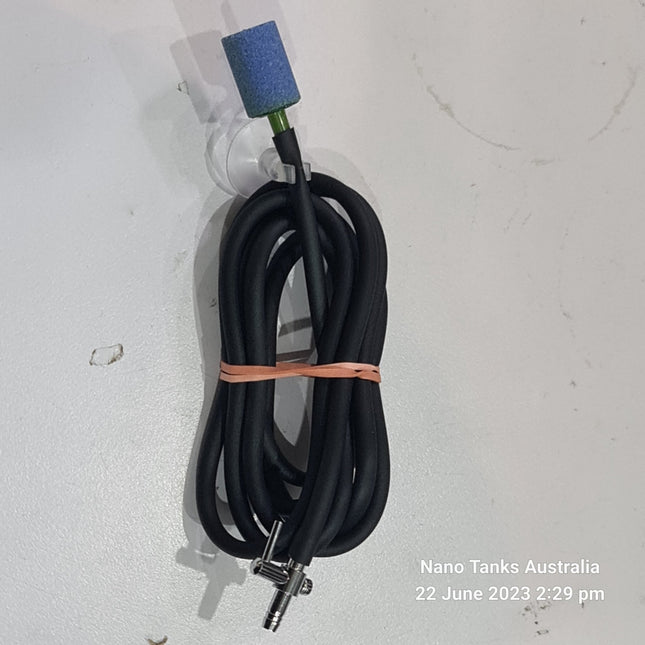
What's in the kit? 1.5m of Airline 1x 25mm Airstone 1x Airline Suction 1x Steel Valve Why is Drip Acclimating shrimp before placing them in their new tank important? When adding new shrimp into your established already existing tank it is important to take the proper steps in introducing and acclimating them into their new home. The whole process is extremely stressful to the shrimp The Drip acclimation system helps with this by getting your shrimp used to your aquarium water. Drip acclimation can help reduce shock, as the shock will affect shrimps and can lead to a shorter life expectancy, can cause death, causes stress, and chances of not eating. So acclimating shrimps by the drip method is essential to giving your shrimps a chance to survive in their new environment. Also, for any water changes in the future a drip system will assist, allowing a soft and gradual water change and not shocking the environment as especially Total Dissolved Salts (TDS) & PH must be kept within the correct water parameters and a sudden water change may disturb these parameters. Plan and prepare acclimation: Temperature Check When first arriving home check the temp in the bag vs the temperature in your tank. If it is not the same, float the shrimp in a bowl or something that won’t let water in. If using a regular bag from the fish store you can float that. Drip Acclimation Importance Once the temperature is close to the same then proceed to acclimating the shrimp. Acclimating shrimp should always be done with the drip method. The drip method can be done very simply with airline tubing, a control nozzle, a bucket/bowl, and a shrimp net. There are also products you can buy out there that are designed to do the drip method. I would stick with the basic airline tubing one we stated above. How To Drip Acclimate Empty your shrimp from their bag or bowl into the bucket, including the water from the bag. Now connect the control nozzle to one end of the tubing and place that end in your bucket and the other into your tank. Start a siphon by sucking on one end of the tubing (Make sure the control nozzle is fully open, otherwise your risk looking stupid and your shrimp may laugh at you). Watch the tubing as it fills with water, try not to get any in your mouth, and use your finger to cap the end of the tubing. Now lower the tubing into your bucket where the shrimp are and let go. Take a moment to make sure the siphon is working then adjust the nozzle to the desired flow, which I recommend to be 2-3 drops of water every second. You want to 4x the amount of water in the bucket. So 1/4 is your bag water from the LFS (Local Fish Store) and 3/4 is new water from your tank. The key after you have done the following steps is to now wait… The dreaded moment of nothingness… It should take roughly 1.5-2.5 hours for the shrimp to be ready. The drip method helps to allow the shrimp to adjust to the pH and other water parameters in your tank. This prevents them from being shocked by sudden changes and thus reduces stress… This reducing stress thing must be important, we have highlighted it several times! After You Drip Acclimate Now that your drip method is complete you should now net the shrimp into the aquarium. Leaving your tank light off for the first 24 hours (the lighting will add unneeded stress), also as much as you want to feed these little guys... don't, they will be fine for the first 24 hours, lastly NEVER PUT STORE WATER INTO YOUR TANK! Putting stored water in your tank can potentially allow all sorts of unwanted parasites, bacteria, and fungus into your tank and this is not good!! Reference https://www.theshrimpfarm.com/posts/acclimating-shrimp/
$9.95
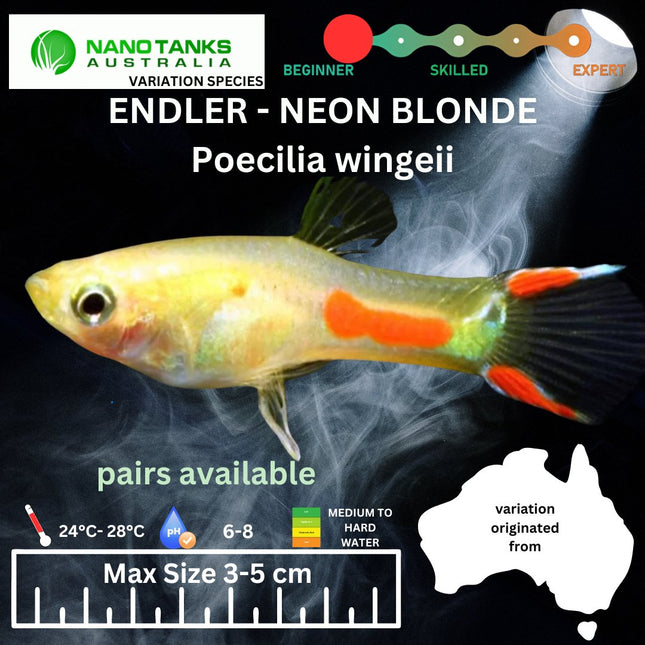
When buying endlers we recommend either going all males or a ratio of 1 male to 2 females or more. this is to ensure the females are not getting too stressed out by the males who will constantly chase them wanting to breed. Temperature: 24 – 28°C pH: 6.5 – 7.8 Hardness: 8-12 dGH Lifespan: 2+ years Max Size: 3-5cm Diet: Omnivore
$8.00 - $10.00

Malaysian Trumpet Snail Care Is Easy Trumpet Snail care can be broken down into a couple of areas: shell size, tank size, water parameters, diet, lifespan and reproduction. As a matter of fact, Malaysian Trumpet Snail Care is so easy, it is considered a good snail for beginners. Shell Size and Color: Malaysian Trumpet Snails have elongated shells that resemble a sugar cone. The shells appear to grow in rings as they swirl up from the apex. Shells can be solid or have patterns with colors ranging from brown, grey and creamy-white. Malaysian Trumpet Snails start life very small. Under the right conditions they can grow to about an inch in length from apex to aperture. At their widest point, their shells can be about the diameter of a pencil eraser. Malaysian Trumpet Snails need Calcium for healthy shell growth, so make sure calcium is available in their diets. Lifespan: In general, Malaysian Trumpet Snails live about one year. They can live longer under the right conditions and with a spot of luck. If a Malaysian Trumpet Snail dies above the substrate, it will be lying motionless on the bottom of the tank. If it dies while buried, it may not be noticed until the substrate is stirred up. While its good practice to remove dead inhabitants from tanks quickly to avoid water quality issues, some hobbyists choose to leave empty Malaysian Trumpet Snail shells in the tank, letting their minerals dissolve back into the aquarium water. Tank Size: One of the best things is that Malaysian Trumpet Snail care is easy and effortless. Trumpet Snails can live in small covered tanks like 5 or 10 gallon setups or larger tanks as well. Just keep in mind they are living organisms that produce waste and tax the bio-load capacity of their aquatic world. So be mindful of the tank’s limitations and avoid overstocking. Tank Hazards Filter Intakes: Sometime, strong power filter intakes can be hazardous or fatal to Malaysian Trumpet Snails. Their small shells can get sucked up by the water current and they can get caught in the slats. The pull of the water can be overpowering and they can die stuck to the intake. So many hobbyists chose to cover intakes with sponge pre-filters to help keep the snails safe. Tank Conditions For Trumpet Snails Water Parameters: Trumpet Snails seem to need little hands-on attention. As long as tank conditions are right, they will thrive in established tanks without much effort. While Malaysian Trumpet Snails can do well in a wide range of water parameters, it’s good to keep conditions in the freshwater community tank range: Aquarium pH: 7.0 – 7.5, with water on the hard sideWater Temperature: 70 – 78 Degrees FahrenheitLighting: Standard community tank lighting Malaysian Trumpet Snail care is similar to caring for other snails and shrimp. It’s important to test tank water often. Make sure Ammonia and Nitrite levels stay at 0 ppm, and control Nitrate levels as well as organic matter buildup with regular partial water changes. It’s also important that water be kept on the hard side as this is necessary for healthy shell growth. Be very careful when using plant fertilizers and medications as some of the ingredients may be harmful to Trumpet Snails. Most importantly, avoid copper, because even in small amounts, copper can be fatal. Malaysian Trumpet Snail Food: Habitat & Behavior Malaysian Trumpet Snails are ferocious eaters spending most of the day under the substrate. They dig through substrate in search of edible matter that has accumulated on the tank bottom. When the tank lights go off, Trumpets can be seen moving up from the substrate to scour other hard surfaces for food. The next day, the snails burrow back into the substrate to spend lighted hours buried and out of site. While digging, their long mouth appears, extending well beyond their shells resembling an elephant trunk. Food Sources: Malaysian Trumpet Snails like left-overs including uneaten fish food, fish flakes, bottom feeder tablets, pellets, and algae wafers. They also enjoy all sorts of debris, detritus and soft algae growing on hard surfaces. Malaysian Trumpet Snails enjoy tanks with lots of live plants. The live plants continuously shed edible material adding to the snails natural diet. Malaysian Trumpet Snails do not seem interested in eating live plants, just the debris. Reproduction: Malaysian Trumpet Snails reproduce very quickly and in large numbers, especially if food is abundant. Other things being equal, the more food there is, the more Malaysian Trumpet Snails will reproduce. One of the ways hobbyists control Malaysian Trumpet Snail populations is to limit food levels long term. Malaysian Trumpet Snail Tank Mates Malaysian Trumpet Snails are peaceful and should be in tanks with other non-aggressive tank mates. Trumpet Snails can do well with Mystery Snails, Nerite Snails, Red Ramshorn Snails, Gold Inca Snails, Ivory Snails and of course others of their kind. Malaysian Trumpet Snails can also blend well with filter feeding shrimp like Bamboo Shrimp and Vampire Shrimp, as well as algae eating shrimp such as Amano Shrimp, Ghost Shrimp, and Red Cherry Shrimp. Malaysian Trumpet Snails also can mix with Freshwater Clams under the right conditions. Calm community tank fish the likes of Cory Catfish and Otocinclus Catfish are also good tank mates for Malaysian Trumpet Snails. If there is any question regarding tank mates, check with the clerk at the store before purchasing. Reference: https://www.aquariumcarebasics.com/freshwater-snails/malaysian-trumpet-snails/
$5.00
![[ALWAYS IN STOCK] Guppy Grass aka Pearlweed (Najas guadalupensis) - The Versatile Aquarium Carpet Plant - Nano Tanks Australia](http://nanotanksaustralia.com.au/cdn/shop/files/always-in-stock-guppy-grass-aka-pearlweed-najas-guadalupensis-the-versatile-aquarium-carpet-plant-5845063.jpg?v=1759763041&width=645)
The Ultimate Versatile Plant for Any Aquarium! PORTION SIZE: 5 Stems approx 10cm each. Great to start your tank in. Short Description:Discover Pearlweed - the incredibly adaptable aquarium plant that does it all! Whether you want a lush carpet, a dense bush, or floating surface cover, this fast-growing plant delivers stunning bright green results. Perfect for beginners and aquascaping pros alike. Key Features & Highlights 🌱 INCREDIBLY VERSATILE: Use as carpeting plant, bushy midground, or floating surface cover - adapts to any placement 💨 FAST GROWTH: Quickly fills in empty spaces and helps control algae by consuming excess nutrients 💪 EASY & LOW LIGHT: Thrives in low to moderate light without CO2 injection - perfect for beginner plant keepers 🦐 SHRIMP & FRY PARADISE: Dense growth provides perfect hiding spots and grazing surfaces for shrimp and baby fish ✂️ EASY PROPAGATION: Simply trim and replant stems to quickly multiply your plant collection Detailed Description Meet Pearlweed, the unsung hero of the aquarium plant world! This North American native has earned its place in aquariums worldwide thanks to its remarkable adaptability and vigorous growth. Whether you're creating your first planted tank or designing an elaborate aquascape, Pearlweed delivers stunning results with minimal effort. What makes Pearlweed truly special is its chameleon-like ability to adapt to how you plant it. When regularly trimmed, it forms a dense, bright green carpet that rivals more demanding plants. Left to grow taller, it creates beautiful bushy clumps perfect for midground placement. And when left floating, it provides valuable surface cover for shy fish and breeding tanks. This plant is particularly valuable for new aquarists, as its fast growth provides immediate satisfaction and helps establish tank balance. For experienced hobbyists, it's an essential tool for filling spaces and creating natural-looking aquascapes without the high maintenance requirements of more delicate species. Perfect For: Beginner planted tanks Carpeting experiments Shrimp and fry tanks Fast-filling new setups Low-tech aquariums Breeding tanks Specifications & Care Guide Parameter Requirement Scientific Name Najas guadalupensis Common Names Pearlweed, Guppy Grass Lighting Low to High CO2 Requirement Not Required (Benefits from supplementation) Growth Rate Very Fast Difficulty Level Easy Placement Foreground, Midground, or Floating Temperature 68°F - 82°F (20°C - 28°C) Propagation Stem cuttings Planting & Maintenance Planting Methods: Carpeting: Plant small stems close together and trim regularly Bushing: Group several stems together and allow to grow upward Floating: Simply drop stems in water - they'll naturally float and grow Maintenance: Trim weekly to maintain desired shape Replant trimmings to fill bare spots Thrives with regular liquid fertilizers Can grow 1-2 inches per week in optimal conditions Benefits: Rapidly improves water quality Provides oxygen through photosynthesis Reduces algae competition Creates natural habitat for aquatic life Important Considerations ⚠️ FAST GROWTH: Requires regular trimming to prevent overgrowth 🚫 CAN BECOME INVASIVE: Dispose of trimmings carefully, don't release into local waterways 🌿 VERSATILE BUT MESSY: Floating growth can appear unkempt if not maintained 🐠 EXCELLENT COVER: Ideal for breeding tanks and shy species 💡 ADAPTS TO LIGHT: Growth pattern changes based on light intensity 🔄 EASY TO CONTROL: Simple to remove or thin out if it grows too vigorously Healthy Plant Guarantee Our Pearlweed is grown in optimal conditions and shipped with careful packaging to ensure it arrives fresh and healthy. Each portion is pest-free and ready to plant upon arrival. Ready to transform your aquarium with this versatile plant? Add Pearlweed to your cart today!
$6.00
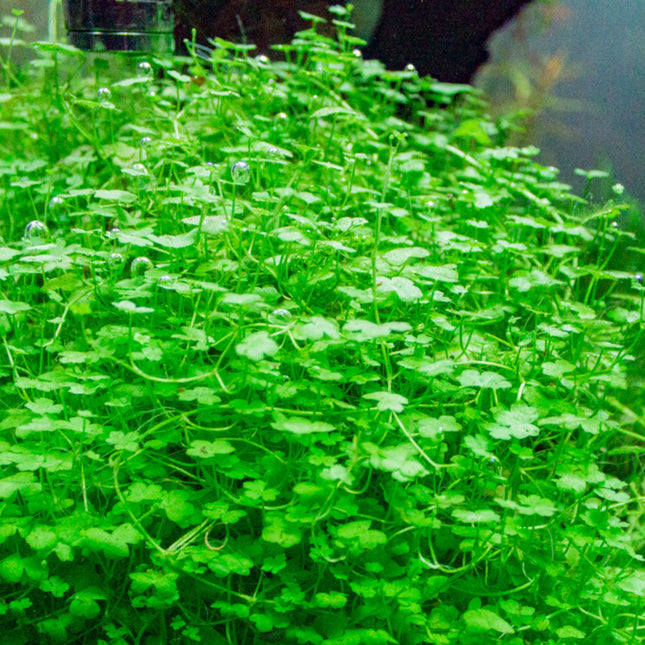
Hydrocotyle tripartita is a delicate foreground plant that can be grown in both low- and high-tech setups. It has light green clover leaves, which are particularly well suited to nano aquariums. Trim the long stems if you want this plant to remain small. Hydrocotyle Tripartita needs oxygenation for optimal growth, but it can also grow immersed or emersed--it's beautiful addition for wabi kusas with limited lighting! Under inadequate light these plants become leggy and start reaching towards the surface; trim them when they get too tall so it will maintain its desired form. NOTE: 5 stems 10cm each on each one If the quantity is zero it means we are letting the plant rest and regrow
$15.00
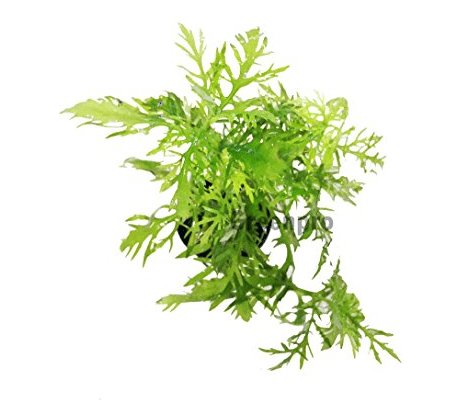
It can be kept as a mid-ground or background plant in tanks of a minimum 10 gallons. The water should be soft to moderately hard and pH should be 6.5-7.5, but it has been noticed this plant will thrive in any conditions, though fertilizers should still be added. The water wisteria does best in water temperatures of 75-82 degrees Fahrenheit. Planting your Water WisteriaThe best substrate for this plant is a specialty plant substrate very rich in nutrients. It can still grow in small grain gravel or sand substrate, as long as you keep fertilizing it with fertilizing tabs, but be careful to anchor the wisteria if you plant it in sand until the roots are well established in the substrate to avoid accidental uprooting. The water wisteria makes a good mid- to background aquarium plant, but can also be grown as a carpet. For this, you have to plant it on its side and make sure the roots are developed along the stem This way, leaves will only grow on one side and extend along the substrate to create a carpet effect. For a more striking effect, plant it between rocks or pieces of wood or next to other contrasting plants. Care for your Water WisteriaThe water wisteria is very easy to care for, as it thrives in many conditions even without CO2 supplementation. For the best look and sturdy leaves, make sure you provide a nutrient rich substrate or at least constant fertilizing with tabs. Fertilizing is very important, as the plant needs nitrate, phosphate, and, most importantly, iron to have a healthy development. Iron deficiency can easily be noticed if the leaves turn pale and yellowish. Remove any dead or brown sections to prevent infections from spreading throughout the plant; this also allows it to use its energy and nutrients only for the healthy leaves and stems. Occasional trimming may be needed to make sure light and nutrients reach all the stems and roots. You can always replant the stems you trimmed if you want lush vegetation. It will grow well under moderate light, but strong light will help accelerate the wisteria’s growth rate and maintain the most intense colors. ReproductionPropagation is conducted through stem or leaf cutting near the base of the mother plant. Plant cuttings will soon grow their own roots and develop into a new plant; if you keep cutting and replanting, newly developed shoots from each plant will form a bushy effect and you can even leave the plant to propagate by its own shoots to allow it to cover a larger surface. We sell wisteria in terracotta pots for easy planting Reference: https://www.theaquariumguide.com/articles/water-wisteria-guideImage: https://images.app.goo.gl/PeWXMJhdYdDJ5NgN7
$10.00 $5.00
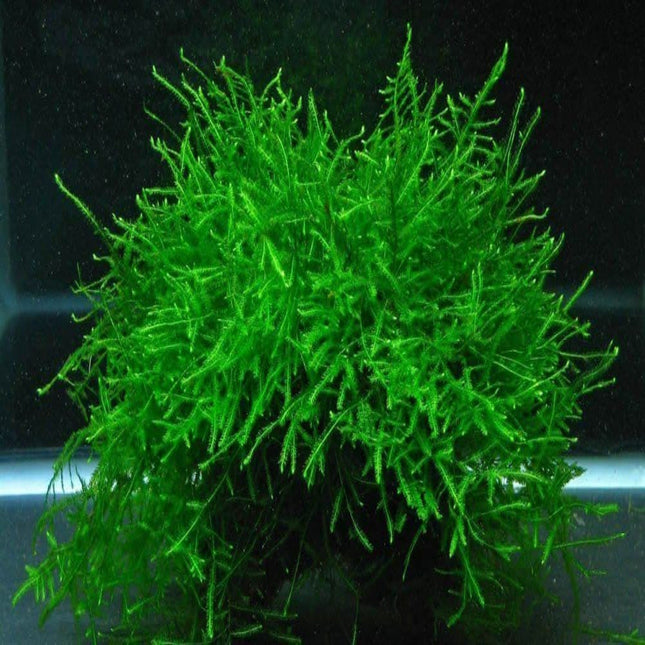
Java moss is one of the easiest to grow, and hardy, aquarium plants around. It belongs to the Hypnaceae family and is native to Southeast Asia. It is very common in moist tropical climates and grows on rocks, river banks and tree trunks. Due to its low requirements regarding water quality and lighting, it is perhaps the most common moss amongst freshwater aquarists and is widely available both in shops and online. It is commonly used for aquascaping and can produce beautiful results. It also has many other benefits such as providing protection for eggs and fry, improving tank health and providing food for breeding fish. Category Rating Care Level: Very easy Growth Rate: Low to Bright Temperature: 15 to 30C (59-86F) PH: 5.0 to 8.0 Reference: https://www.fishkeepingworld.com/java-moss/ Portion Size: 5x5cm when laid out flat which equates to 5 grams weight (without excess water) We send Java Moss orders via Unregistered post
$10.00 $5.00
![[ALWAYS IN STOCK] MarinePure® 8"x8"x1" Biofilter Block – Maximum Surface Area for Superior Biological Filtration - Nano Tanks Australia](http://nanotanksaustralia.com.au/cdn/shop/files/always-in-stock-marinepure-8x8x1-biofilter-block-maximum-surface-area-for-superior-biological-filtration-276488.png?v=1749544551&width=645)
MarinePure® Biofiltration Blocks – The Complete Nitrification & Denitrification Solution Advanced Biological Filtration for All Aquatic Systems Specially engineered ceramic blocks providing dual-action water purification:✔ Eliminates Ammonia/Nitrites (aerobic nitrification)✔ Reduces Nitrates (anaerobic denitrification)✔ Works in Freshwater & Saltwater✔ Perfect for Sump or Wet/Dry Filters Unmatched Performance 8"x8"x1" Block Features:• 139,800 ft²/ft³ surface area – 1,400x more than bio-balls!• 80-90% open porosity – Allows deep anaerobic bacteria colonization• Ultra-lightweight (0.3-0.5 g/cc) yet durable• Chemically inert – Won’t alter water chemistry Flow Recommendations:→ Fast flow = Maximum ammonia/nitrite removal→ Slow flow = Enhanced nitrate reduction Sizing Guide For Nitrification (Active Systems): Tank Size Blocks Required 100 gal 1 block 250 gal 1 block 500 gal 1-2 blocks For Denitrification (Passive Systems): Tank Size Blocks Required 50 gal 1 block 100 gal 1 block 500 gal 3 blocks Why MarinePure Outperforms ✅ 10,000% more surface area than plastic bio-balls✅ Simulates live rock filtration without the cost✅ Maintains crystal-clear water 24/7✅ Military-grade ceramic – Never needs replacement Pro Tip: Place blocks in skimmer risers or low-flow zones for maximum nitrate control! Complete Your Filtration System Today!(Also available in Plates, Spheres and GEMS for smaller tanks)
$68.00
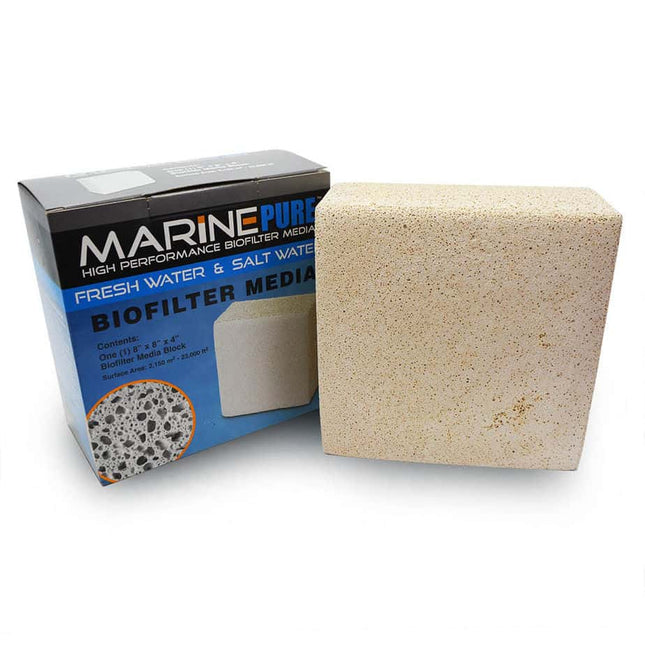
MarinePure® Biofiltration Blocks – The Complete Nitrification & Denitrification Solution Advanced Biological Filtration for All Aquatic Systems Specially engineered ceramic blocks providing dual-action water purification:✔ Eliminates Ammonia/Nitrites (aerobic nitrification)✔ Reduces Nitrates (anaerobic denitrification)✔ Works in Freshwater & Saltwater✔ Perfect for Sump or Wet/Dry Filters Unmatched Performance 8"x8"x4" Block Features:• 139,800 ft²/ft³ surface area – 1,400x more than bio-balls!• 80-90% open porosity – Allows deep anaerobic bacteria colonization• Ultra-lightweight (0.3-0.5 g/cc) yet durable• Chemically inert – Won’t alter water chemistry Flow Recommendations:→ Fast flow = Maximum ammonia/nitrite removal→ Slow flow = Enhanced nitrate reduction Sizing Guide For Nitrification (Active Systems): Tank Size Blocks Required 100 gal 1 block 250 gal 1 block 500 gal 1-2 blocks For Denitrification (Passive Systems): Tank Size Blocks Required 50 gal 1 block 100 gal 1 block 500 gal 3 blocks Why MarinePure Outperforms ✅ 10,000% more surface area than plastic bio-balls✅ Simulates live rock filtration without the cost✅ Maintains crystal-clear water 24/7✅ Military-grade ceramic – Never needs replacement Pro Tip: Place blocks in skimmer risers or low-flow zones for maximum nitrate control! Complete Your Filtration System Today!(Also available in Plates, Spheres and GEMS for smaller tanks)
$129.00
![[ALWAYS IN STOCK] MarinePure® Biofilter PODs – Compact Nitrification Powerhouses - Nano Tanks Australia](http://nanotanksaustralia.com.au/cdn/shop/files/always-in-stock-marinepure-biofilter-pods-compact-nitrification-powerhouses-170576.jpg?v=1749544551&width=645)
MarinePure® BioPods – Ultra-Efficient Biological Filtration for All Aquariums Powerful, Compact Bio-Media for Crystal Clear Water These high-performance ceramic pods deliver maximum surface area in minimal space, creating the perfect home for beneficial bacteria to:✔ Eliminate toxic ammonia & nitrites✔ Stabilize water parameters✔ Support faster tank cycling✔ Work in ANY filtration system Why Choose MarinePure BioPods? 🔹 132,500 ft²/ft³ surface area – 1,300× more than plastic media🔹 Marble-sized design – Fits even the tightest filter compartments🔹 Zero maintenance – Never needs replacement🔹 Freshwater & saltwater safe Simple 3-Step Setup 1️⃣ Place in sump, canister, or HOB filter2️⃣ Ensure water flow (no special positioning needed)3️⃣ For new tanks: Speed colonization with bacteria starter Available in Convenient Sizes Pack Size Tank Capacity Best For 3-Pod Up to 380L Nano/Mid-size tanks 24-Pod Up to 2,800L Large systems/ponds Pro Tips:• Rinse in tank water if flow slows (never tap water!)• Use in reactors for ultra-efficient nitrate control• Combine with mechanical filtration for best results The Smarter Choice for Healthier Fish & Cleaner Water! Need Help Selecting the Right Size?→ Small tanks: 3-Pod Pack→ Reef systems: 24-Pod Pack→ QT/Hospital tanks: 1-Pod per 40L (Also available in bulk for commercial systems!)
$42.00 - $199.00
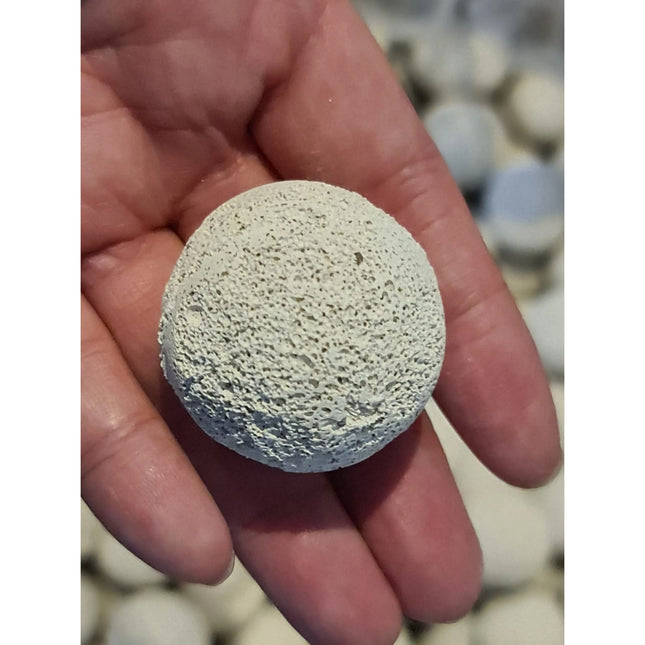
MarinePure® Biofilter Spheres – Military-Grade Filtration Technology The Ultimate Biological Filtration Media Originally developed for U.S. Military waste management systems, MarinePure Spheres now revolutionize aquarium filtration with:✔ World Record Surface Area – 132,500 ft²/m³ (highest of any man-made bio-media)✔ Ultra-Efficient Bacteria Colonization – Perfect home for nitrifying bacteria✔ Proven Military Durability – Long-lasting ceramic construction How to Use for Optimal Results 🔄 Seeding Period: Takes 6-8 weeks for full bacterial colonization Speed up the process with Seachem Stability or similar bacteria starters 📊 Recommended Quantities:• 1 Sphere – Nano tanks (<10L)• 10 Spheres – Small tanks (10-50L, heavily stocked)• 25 Spheres – Medium tanks (50-100L, heavily stocked)• 100+ Spheres – Large systems (100-200L+) 💡 Pro Tip: More spheres = better filtration! Ideal for high-bioload reef tanks or cichlid systems. Why MarinePure Outperforms Conventional Bio-Media ✅ 10X more surface area than traditional bio-balls✅ Maintains crystal-clear water by promoting complete nitrification✅ Doesn’t break down – lasts for years without replacement Get military-grade filtration for your aquarium today! Need help calculating the right amount for your tank? Contact us! (Note: For best results, combine with mechanical filtration and regular maintenance.)
$2.95 - $550.00
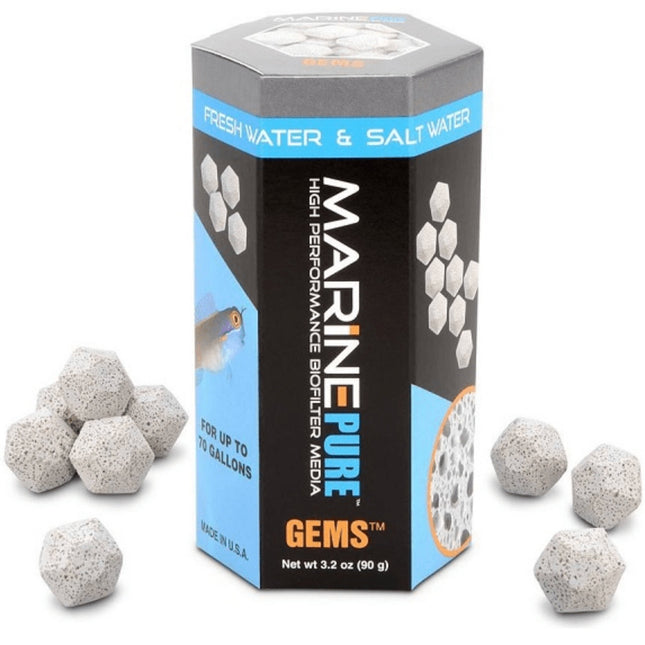
MarinePure® GEMS – Ultra-Efficient Biofiltration for Nano & Small Aquariums *(90g | Filters up to 70 Gallons / 260L)* Supercharge Your Tank’s Beneficial Bacteria! These high-porosity ceramic GEMS provide 1,450 in² of surface area – giving nitrifying bacteria the perfect home to:✔ Reduce harmful ammonia & nitrites faster✔ Lower maintenance by stabilizing water quality✔ Prevent "mini-cycles" when adding new fish✔ Work in ANY tank setup – freshwater or saltwater Why Your Tank Needs MarinePure GEMS 🔹 18-20mm size – Fits even tiny filter chambers🔹 Open-cell structure – 10X more bacteria space than bio-balls🔹 Chemically inert – Won’t alter pH or leach chemicals🔹 Place anywhere – Sump, HOB filter, canister, or overflow box How to Use for Best Results 1️⃣ Rinse lightly (with tank or RODI water)2️⃣ Place in high-flow area (after mechanical filtration)3️⃣ Speed up colonization with bacterial starter (like Microbacter7)4️⃣ See full benefits in 2-4 weeks Package Includes: 90g (3.2oz) of premium MarinePure GEMS Enough for nano tanks up to 70 gallons PRO TIP: Add a few GEMS to your filter when:• Starting a new tank• Increasing fish load• Recovering after medication The Secret to Crystal-Clear Water & Healthier Fish!
$32.00
![[ALWAYS IN STOCK] MarinePure® VAULT – High - Capacity Biofiltration Chamber System - Nano Tanks Australia](http://nanotanksaustralia.com.au/cdn/shop/files/always-in-stock-marinepure-vault-high-capacity-biofiltration-chamber-system-588913.jpg?v=1749544551&width=645)
MarinePure® VAULT – The Ultimate Biofiltration Media Containment System Professional-Grade Filtration Optimization Chamber Key Features:✔ Durable acrylic construction – Built to last in saltwater environments✔ Universal media compatibility – Holds Blocks (8"x8"x4"), Spheres, or 1,500+ GEMs✔ Dual-function design – Biofilter housing + protein skimmer riser✔ Space-saving stackable system for organized sumps Precision Dimensions: Internal: 8"x8"x4" (fits one full block perfectly) External: 9"x9"5.25" (compact footprint) Why Your Sump Needs the VAULT 🔹 30% Better Flow Efficiency vs loose media🔹 Prevents media shifting – Secures your valuable MarinePure investment🔹 Multiplies usable surface area through optimized water contact🔹 Freshwater & saltwater ready Three Professional Applications 1️⃣ High-Efficiency Biofiltration (all media types)2️⃣ Skimmer Elevation Platform (improves protein skimmer performance)3️⃣ Sump Organization System (stackable, space-maximizing design) Technical Advantages:• Acrylic construction – Won't corrode or degrade• Laser-cut flow channels – Maximizes media/water contact• Non-reactive material – Safe for all aquarium types Trusted By: Reef keepers with limited sump space Monster fish enthusiasts running heavy bioloads Public aquariums needing reliable filtration Complete Your System Today!(Pairs perfectly with all MarinePure media - Blocks, Spheres, Plates & GEMs)
$147.00
![[ALWAYS IN STOCK] Phat Fundamental Fertiliser 250ml 500ml 2.75L - Nano Tanks Australia](http://nanotanksaustralia.com.au/cdn/shop/files/always-in-stock-phat-fundamental-fertiliser-250ml-500ml-275l-539509.png?v=1748500858&width=645)
PHAT FUNDAMENTAL – Simplicity Meets Growth The Essential All-in-One Fertilizer for Thriving Planted Tanks PHAT FUNDAMENTAL is the effortless solution for lush, healthy aquarium plants—without the hassle. Perfect for low to medium-light tanks, this all-in-one fertilizer delivers balanced nutrition for vibrant growth, whether you're running a low-tech (non-CO₂) or lightly injected CO₂ setup. Why Choose PHAT FUNDAMENTAL? ✔ All-in-One Formula – No guesswork, just complete plant nutrition in every dose.✔ Optimized for Low to Medium Light – Ideal for easy-care planted tanks.✔ CO₂ Flexible – Works beautifully in non-CO₂ or lightly injected setups.✔ Simple & Effective – Get professional results with beginner-friendly ease. 🌿 Keep It Simple. See It Grow.
$15.00 - $99.00
![[ALWAYS IN STOCK] Phat Pro Fertiliser 250ml 500ml 2.75L - Nano Tanks Australia](http://nanotanksaustralia.com.au/cdn/shop/files/always-in-stock-phat-pro-fertiliser-250ml-500ml-275l-195129.png?v=1748500858&width=645)
PHAT PRO Fertiliser Advanced Nutrition for Thriving High-Tech Planted Aquariums For aquarists who demand professional results, PHAT PRO delivers laboratory-grade nutrients to transform your aquascape. Specifically formulated for:✅ CO₂-injected tanks✅ High-light setups✅ Carpeting plants & demanding species Why PHAT PRO? 🔬 Scientifically Balanced - Precise NPK + microelements ratio for explosive growth🌱 Plant-Optimised - Contains chelated iron for vibrant reds and deep greens⚡ Fast-Absorbing - Bioavailable formula works within 48 hours🧪 Zero Residue - Won’t cloud water or promote algae Dosing Made Simple:5ml treats 100L daily (adjust based on plant mass) Size Options:• 250ml (Treats 5,000L)• 500ml (Treats 10,000L)• 2750ml (Treats 55,000L) Tech Specs:• pH-neutral (6.5-7.5)• Safe for shrimp & fish when used as directed 🚀 Take Your Aquascape to Pro Level
$19.00 - $119.00
![[ALWAYS IN STOCK] Phat Shrimp Fertiliser 250ml 500ml 2.75L - Nano Tanks Australia](http://nanotanksaustralia.com.au/cdn/shop/files/always-in-stock-phat-shrimp-fertiliser-250ml-500ml-275l-542232.png?v=1748500858&width=645)
PHAT SHRIMP SAFE Precision Nutrition for Lush Aquascapes & Thriving Shrimp For the balance-obsessed aquarist who demands vibrant plant growth without compromising shrimp safety. Our copper-free formula delivers: 🌿 Explosive Plant Growth Optimized NPK + trace elements for dense carpets and vibrant stems Enhanced iron uptake for deeper reds and greens 🦐 Shrimp-Safe Assurance Zero detectable copper (lab-tested) Gentle biofilm preservation ⚖️ The Perfect Equilibrium Promotes plant health without triggering algae blooms Stable pH balance for sensitive Caridina and Neocaridina Dosing Perfection:2ml per 50L (3x weekly) - adjust based on plant mass For Those Who Notice the Difference:• Dutch-style aquascapes• High-tech shrimp tanks• Walstad-inspired setups Lab-Grade. Aquarist-Trusted.
$19.00 - $119.00
You have seen 1476 out of 1935 products